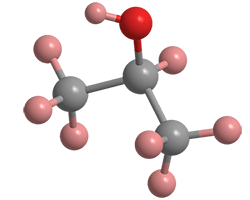What molecule am I?


Isopropyl alcohol (IPA; aka 2-propanol, but never “isopropanol”) is a common solvent, reagent, and disinfectant. It is flammable, with a characteristic odor that is similar to ethanol’s, but more pungent.
IPA dates to 1866 in the chemical literature, when it was mentioned by Eduard Linnemann at the University of Lemberg (Poland)1 in an article about the conversion of propylene oxides to acetone. As described by Carleton Ellis in a 1921 article in Petroleum Magazine, IPA was first produced commercially by Standard Oil in 1920 from paraffin oil–derived propylene via its reaction with sulfuric acid, followed by hydrolysis. Much of the alcohol was then oxidized to acetone.
According to the Merck Index, IPA has a wide range of uses: in antifreeze compositions; as an industrial solvent for gums, resins, and creosote; in quick-drying inks and oils; in cosmetic products such as body rubs, hand lotions, and after-shave formulations; and in the manufacture of acetone, glycerol, and isopropyl acetate. It also has several medical uses, including in rubbing alcohol, hand sanitizers, and “wet wipes”.
In 2022, the global market for IPA was ≈2.3 million tonnes. It is forecast that the volume will grow to ≈2.9 million tonnes by 2030.
1. Now the University of Lviv (Ukraine).
Isopropyl alcohol hazard information
| Hazard class* | GHS code and hazard statement | |
|---|---|---|
| Flammable liquids, category 2 | H225—Highly flammable liquid and vapor | |
| Serious eye damage/eye irritation, category 2A | H319—Causes serious eye irritation | |
Specific target organ toxicity, single exposure, respiratory tract irritation, category 3 | H335—May cause respiratory irritation | |
Specific target organ toxicity, single exposure, narcotic effects, category 3 | H336—May cause drowsiness or dizziness | |
| Specific target organ toxicity, repeated exposure (kidney, liver), category 2 | H373—Causes damage to organs through prolonged or repeated exposure | |
*Globally Harmonized System (GHS) of Classification and Labeling of Chemicals. Explanation of pictograms.
Molecules from the journals
Indium zinc sulfide (In2Zn3S6)1 is a crystalline inorganic compound that was prepared in single-crystal sheets by USSR scientists V. F. Zhitar*, N. A. Goryunova, and S. I. Radautsan* in 1965. The authors described In2Zn3S6 as having photoelectric properties.
This January, Xue-Fang Yu, Kaisheng Zhang, Xiaolong Yang, and collaborators at Qingdao University, Yantai University, and the Chinese Academy of Sciences (Hefei, all in China) reported that In2Zn3S6, with sulfur vacancies, is an ideal photothermal catalyst for promoting the cycloaddition of carbon dioxide to epoxides (e.g., propylene oxide2) to form cyclic carbonates. The authors propose that this reaction system could contribute to CO2 capture and the synthesis of useful materials.
Dihydro-β-ionone3 is a cyclic unsaturated ketone first reported in 1934 by Leopold Ružička4* and W. Fischer at ETH Zurich in the 90th (!) article of a series on polyterpenes and polyterpenoids. The article concentrated primarily on the synthesis of 1-β-cyclogeranylgeraniol; but the authors also prepared dihydro-β-ionone via the partial catalytic hydrogenation of β-ionone5.
Dihydro-β-ionone is one of several ionones (also known as “rose ketones”) that are components of flavor and fragrance products. In January, Su Bu, Longuo Zhao, and co-workers at Nanjing Forest University (China) described a biochemical synthesis of the molecule from glycerol6. They used an Escherichia coli–Saccharomyces cerevisiae coculture to produce dihydro-β-ionone with a titer of 27 mg/L, considerably higher than the 8 mg/L obtained with E. coli alone.
1. CAS Reg. No. 12056-06-3.
2. CAS Reg. No. 75-56-9.
3. CAS Reg. No. 17283-81-7.
4. Ružička was a co- winner of the 1939 Nobel Prize in Chemistry for his work on polyethylene and terpenes.
5. CAS Reg. No. 79-77-6.
6. CAS Reg. No. 56-81-5.
Molecules from the Journals
MOTW briefly describes noteworthy molecules that appeared in recent ACS journal articles. See this week's edition.
This molecule was suggested by a reader. We present almost all of the molecules suggested by our readers. If you have a molecule that you would like us to consider, please send us a message, preferably including links to references about your suggested molecule. And thank you for your interest in Molecule of the Week! —Ed.
Isopropyl alcohol
fast facts
| CAS Reg. No. | 67-63-0 |
| SciFinder nomenclature | 2-Propanol |
| Empirical formula | C3H8O3 |
| Molar mass | 60.10 g/mol |
| Appearance | Colorless liquid |
| Boiling point | 82.5 °C |
| Water solubility | Miscible |

Learn more about this molecule from CAS, the most authoritative and comprehensive source for chemical information.
Molecule of the Week needs your suggestions!
If your favorite molecule is not in our archive, please send us a message. The molecule can be notable for its current or historical importance or for any quirky reason. Thank you!
Stay Ahead of the Chemistry Curve
Learn how ACS can help you stay ahead in the world of chemistry.

